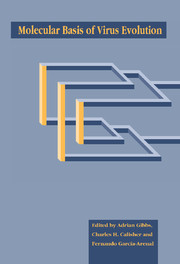Book contents
- Frontmatter
- Contents
- List of contributors
- Editors' preface
- Conference participants
- 1 Introduction and guide
- Part I The impact of viral diseases
- Part II Origins of viruses and their genes
- Part III Sources of virus variation
- Part IV Molecular interactions of viruses and their hosts
- Part V Viruses, hosts and populations
- Part VI Case studies of viral taxa; their systematics and evolution
- 18 Evolution of poxviruses and African swine fever virus
- 19 Molecular systematics of the flaviviruses and their relatives
- 20 Herpesviridae
- 21 Aphthovirus evolution
- 22 Evolution of the Bunyaviridae
- 23 Evolution of the tobamoviruses
- 24 The luteovirus supergroup: rampant recombination and persistent partnerships
- 25 The evolution of the Reoviridae
- 26 Genetic variation and evolution of satellite viruses and satellite RNAs
- 27 Molecular evolution of the retroid family
- 28 Adaptation of members of the Orthomyxoviridae family to transmission by ticks Patricia
- 29 The Order Mononegavirales: evolutionary relationships and mechanisms of variation
- 30 The molecular evolution of the human immunodeficiency viruses
- 31 Molecular evolution of papillomaviruses
- 32 Molecular systematics of the Potyviridae, the largest plant virus family
- 33 Evolution of alphaviruses
- 34 Evolution of influenza viruses: rapid evolution and stasis
- Part VII Techniques for viral systematics
- Index
33 - Evolution of alphaviruses
Published online by Cambridge University Press: 04 May 2010
- Frontmatter
- Contents
- List of contributors
- Editors' preface
- Conference participants
- 1 Introduction and guide
- Part I The impact of viral diseases
- Part II Origins of viruses and their genes
- Part III Sources of virus variation
- Part IV Molecular interactions of viruses and their hosts
- Part V Viruses, hosts and populations
- Part VI Case studies of viral taxa; their systematics and evolution
- 18 Evolution of poxviruses and African swine fever virus
- 19 Molecular systematics of the flaviviruses and their relatives
- 20 Herpesviridae
- 21 Aphthovirus evolution
- 22 Evolution of the Bunyaviridae
- 23 Evolution of the tobamoviruses
- 24 The luteovirus supergroup: rampant recombination and persistent partnerships
- 25 The evolution of the Reoviridae
- 26 Genetic variation and evolution of satellite viruses and satellite RNAs
- 27 Molecular evolution of the retroid family
- 28 Adaptation of members of the Orthomyxoviridae family to transmission by ticks Patricia
- 29 The Order Mononegavirales: evolutionary relationships and mechanisms of variation
- 30 The molecular evolution of the human immunodeficiency viruses
- 31 Molecular evolution of papillomaviruses
- 32 Molecular systematics of the Potyviridae, the largest plant virus family
- 33 Evolution of alphaviruses
- 34 Evolution of influenza viruses: rapid evolution and stasis
- Part VII Techniques for viral systematics
- Index
Summary
Alphavirus structure, replication and transmission cycles
Structure and replication
Alphavirus is a genus of arthropod-borne viruses (arboviruses) in the family Togaviridae (Calisher et al., 1980; Calisher & Karabatsos, 1988). These viruses have unsegmented, single-stranded RNA genomes of 11–12 kb which are of positive or messenger sense. Alphavirus genomic RNA encodes four non-structural proteins, designated nsP1–4, as well as three structural proteins: the capsid, and two envelope glycoproteins, El and E2 (Fig. 33.1). A sub-genomic 26S RNA species, which encodes only the structural proteins, is also produced in infected cells.
Alphaviruses replicate in the cytoplasm of infected cells. Entry into vertebrate cells occurs via receptor-mediated endocytosis (Kielian & Helenius, 1986). The high-affinity laminin receptor serves as a mammalian and mosquito cell (in vitro) receptor for the alphavirus, Sindbis (SIN) (Wang et al., 1992), whereas other protein receptors for SIN have been identified in mouse neural (Ubol & Griffin, 1991) and chicken cells (Wang et al., 1991). Wang et al. (1992) believe that the wide host range of Sindbis virus is the result of its utilization of a highly conserved receptor, found in a variety of vertebrates and in mosquito cells (laminin receptor), as well as its use of multiple receptors. The mechanism of alphavirus entry into mosquito cells has not been identified, although the very specific infectivity patterns of some alphaviruses for their mosquito vectors suggest use of a less conserved protein receptor during initial infection of the midgut.
Genomic alphavirus RNA is translated by cellular components to produce the non-structural proteins, and also serves as a template for minus-strand RNA synthesis involving the non-structural proteins.
- Type
- Chapter
- Information
- Molecular Basis of Virus Evolution , pp. 501 - 530Publisher: Cambridge University PressPrint publication year: 1995
- 10
- Cited by



